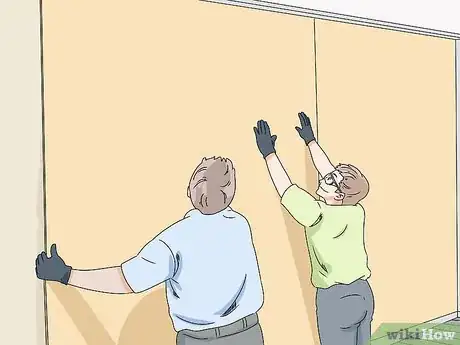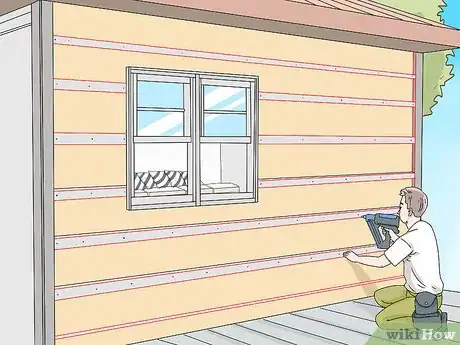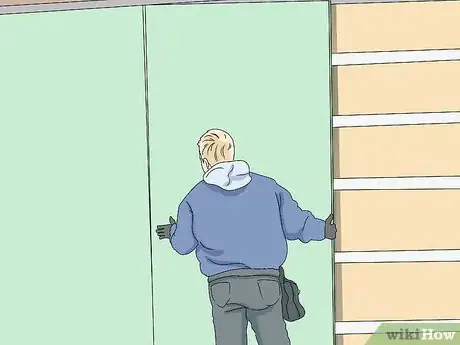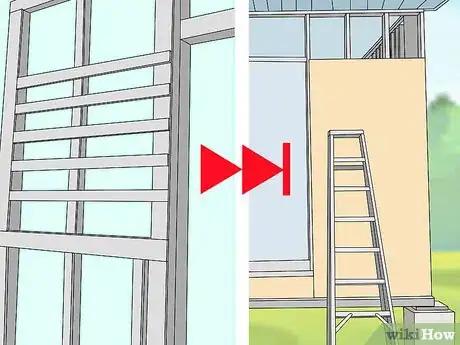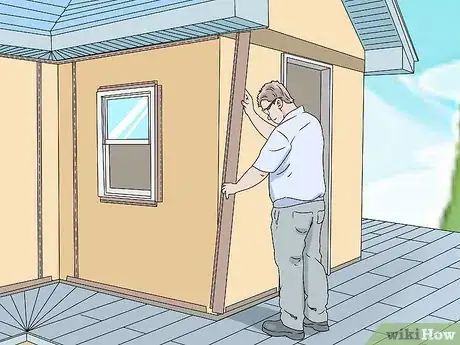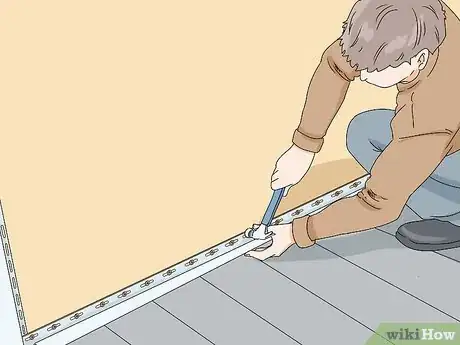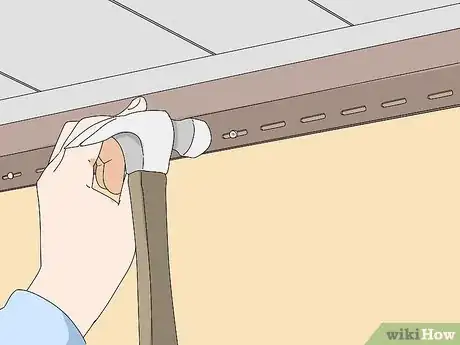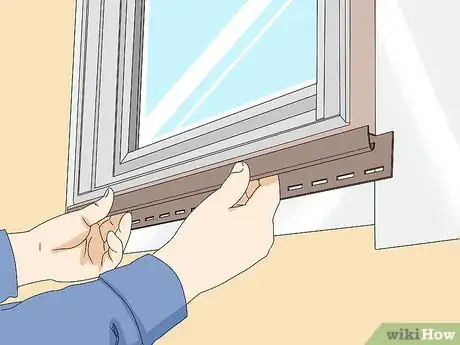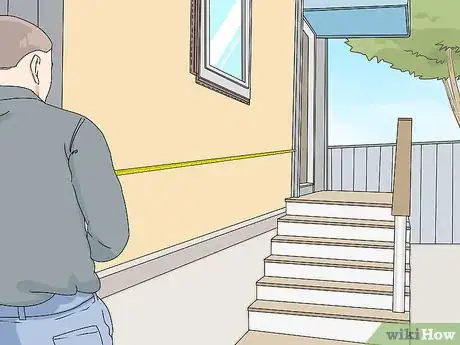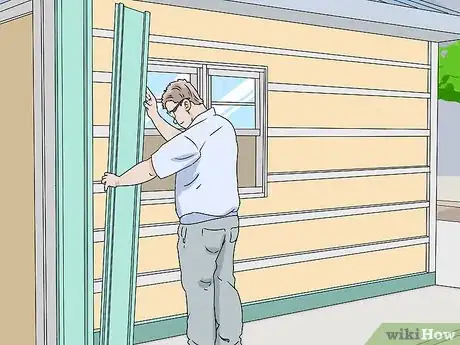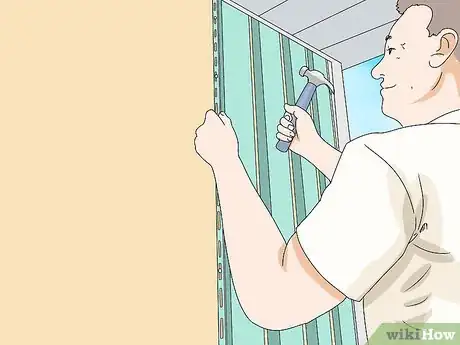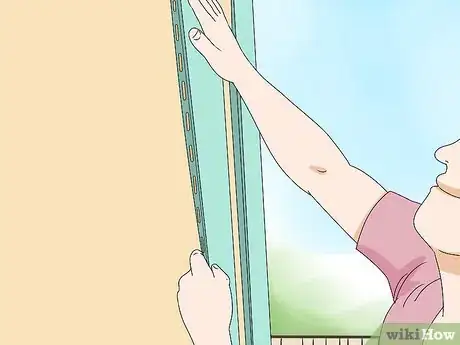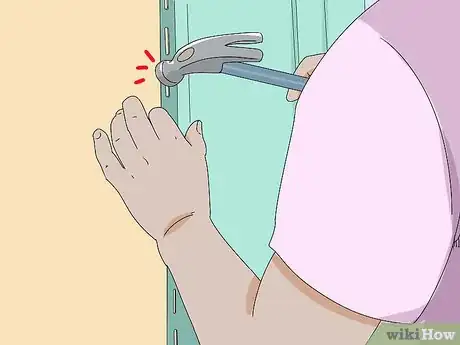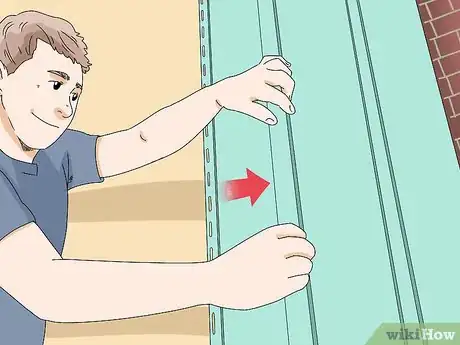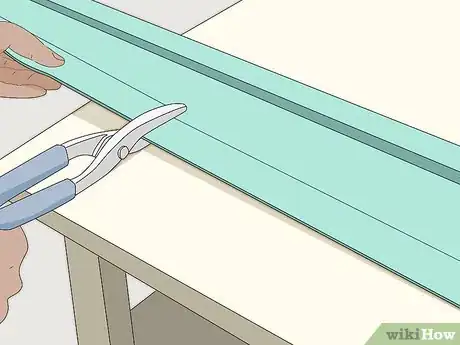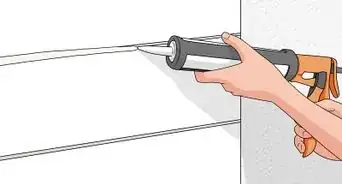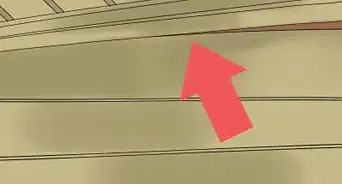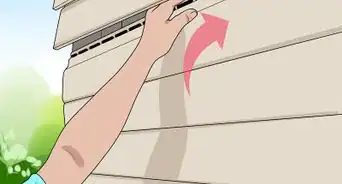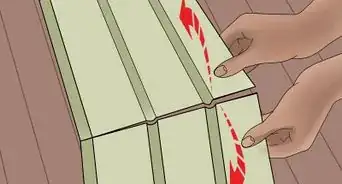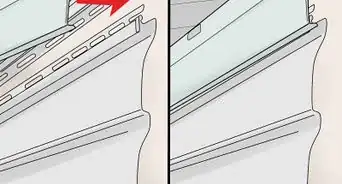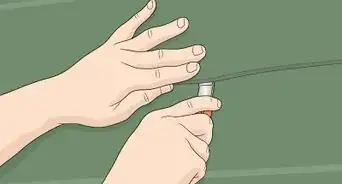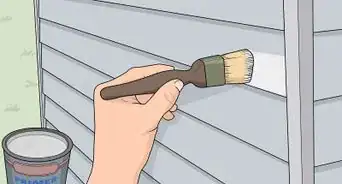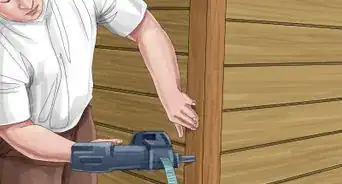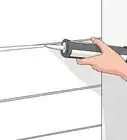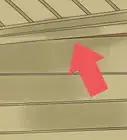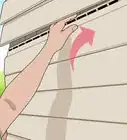This article was co-authored by Alberto DeJesus and by wikiHow staff writer, Kyle Hall. Alberto DeJesus is a Construction Specialist and the CEO of DeJesus Industries. With more than four years of experience, he specializes in high-end real estate development and construction. Alberto and DeJesus Industries have been featured on NBC News and have worked with numerous well-known companies, including Mazda, Amazon, and CVS. Alberto holds a Bachelor’s degree from Boston University.
There are 13 references cited in this article, which can be found at the bottom of the page.
This article has been viewed 77,607 times.
Vertical metal siding can give a building a modern, sleek appearance. While installing vertical metal siding is similar to installing horizontal siding, there are a few differences you'll want to keep in mind. Fortunately, with the right tools and preparation, putting vertical metal siding up on a building can be a smooth and simple process.
Steps
Installing Furring Strips and Sheathing
-
1Inspect the surface you're working on to see if it's level. Metal siding looks best when it's installed on a flat, level surface. If the surface you're working on is uneven, the metal siding will look wavy and distorted. Check the wall beforehand so you know whether or not you'll need to level it out before you get started.
- Use a level to see if the surface is even and feel for any noticeable dips or bumps in the wall with your hands.
-
2Install horizontal furring strips every 16 inches (41 cm) if the wall is uneven. Furring strips are thin, wooden strips that you can find at your local hardware store. Putting up furring strips will help even out the surface you're working on so the metal siding doesn't look wavy.
- To install the furring strips, start by cutting them to size so they run from one end of the surface to the other. Then, nail them to the surface you're working on, leaving 16 inches (41 cm) between each strip.
- Make sure you install the furring strips horizontally and not vertically. They need to run in the opposite direction of the metal siding.
Advertisement -
3Apply sheathing over the wall if you installed furring strips. Installing a layer of sheathing, like plywood, over the furring strips will give you an even, insulated surface to work on. Simply cut the material to size and nail it to the furring strips so the entire surface is covered.[1]
- Choose sheathing that's no more than 1 inch (2.5 cm) thick so you're not building too far out from the wall.
- You can find sheathing at your local home improvement center.
-
4Skip furring strips and sheathing if you're working with an even surface. Sometimes it's not necessary to even out the surface you're working on, especially if you're installing siding over a relatively new building. If that's the case, you can put the metal siding up on the wall as is.
Applying the J-Channel
-
1Install the corner posts that came with your metal siding first. The corner posts are the pieces of siding that will wrap around the corners of the surface you're working on. The exact installation process may vary depending on the siding you're using, but generally you will need to position the posts on the corners and then nail them into place using the cut-out nail slots.[2]
- Hammer in a nail about every 12 inches (30 cm) down both sides of the corner posts.
-
2Nail j-channel along the bottom of the wall you're working on. J-channel is an accessory to the siding that's used to receive and hide the ends of the panels so the final product has a smooth and finished appearance. Use the nail slots on the j-channel to secure it to the wall, just like you did with the corner posts.[3]
- You'll need to measure and cut the j-channel to size so it fits along the bottom edge of the surface you're working on. Leave a 1⁄4 inch (0.64 cm) gap between each end of the j-channel and the corner posts so it has room to expand and contract.[4]
- You can cut j-channel using tin snips or a power saw.
-
3Install j-channel along the top edge of the wall. The j-channel at the top of the surface you're working on will receive one end of the siding panels, while the j-channel at the bottom will receive the other end. Nail j-channel along the top of the wall just like you did with the j-channel at the bottom, except this time the nail slots should be facing down.[5]
- Leave a 1⁄4 inch (0.64 cm) gap at each end like you did with the other j-channel.[6]
-
4Secure j-channel around the edges of any windows and doors. If there are any windows or doors on the surface you're working on, some of the metal siding will need to be secured to the edges of them. Therefore, there needs to be something there to receive and conceal the ends of the siding, which is where the j-channel comes in. Install the j-channel like you did along the top and bottom of the wall, with the bottom edge of the j-channel pushed up against the edge of the windows or doors.[7]
- There needs to be j-channel along each edge of the frame around any windows or doors.
- If your windows or doors already have a built-in receiver for siding, you don't need to install j-channel around them.
Putting up the Siding
-
1Measure the length of the wall to see how many panels you'll need to use. Depending on the length of the wall, you may need to cut and use partial panels. For example, if the wall is 11 feet (3.4 m) long, and each siding panel is 2 feet (0.61 m) long, you would need 5 panels and 1 half-size panel.[8]
- Measure the wall before you start installing the panels so you know exactly how many panels and partial panels you need to use.
- Siding panels come in different sizes depending on the brand and type that you purchase, so make sure you measure your panels before you get started.
- If you need to cut your panels to size, you can use tin snips or a power saw.
-
2Distribute partial panels evenly on both sides of the wall for a balanced finish. To keep your vertical metal siding looking polished and balanced, you want to avoid installing a partial panel on only one side of the wall. Instead, you should cut two partial panels that are each half the length of the partial panel you need and install them on each end of the wall.[9]
- For example, if you need to use a partial panel that's 1 foot (0.30 m) long for your installation, you would cut two 6 in (15 cm) panels that would go on the ends of the wall.
- If you cut partial panels, punch tabs every 6 inches (15 cm) along the cut edge to use as nail slots.
- If you don't need to use partial panels for your installation, you can skip this step.
-
3Nail furring and utility channels along the corners if you're using partial panels. Since you'll be cutting off the edges that are supposed to snap into the corner posts when you make partial panels, you'll need to install a vertical furring strip and utility channel next to the corner posts so the partial panels have something to lock into. First, nail the vertical furring strip to the sheathing so it runs along the edge of the corner post. Then, insert a strip of utility channel into the edge of the corner post and nail it into place using the nail slots.[10]
- If you're not using partial panels for your installation, there's no need to install furring strips or utility channels.
-
4Install the first panel by snapping it into the receiver on the corner post. Line the edge of the panel that doesn't have the nail slots up with the edge of the corner post and then slide it into place. You should hear it click as it locks into place.[11]
- If you're using a partial panel, slide the cut edge of the panel into the utility channel you installed until it locks into place.
- Make sure the top and bottom ends of the panel are locked into the j-channel you installed along the top and bottom of the wall earlier.
-
5Hammer nails into the nail slots every 16 inches (41 cm) down the panel. Once one edge of the panel is locked into place, you'll need to nail the other edge to the sheathing to secure the panel.[12]
- Make sure you hammer a nail into the top and bottom nail slots on the panel.
-
6Install the second panel so it overlaps with the first panel. First, snap the edge of the second panel into the receiving groove on the first panel so it locks into place. The second panel should cover the nails that you used to secure the first panel to the sheathing. Then, nail the second panel to the sheathing just like you did with the first panel.[13]
-
7Repeat with the rest of the siding panels. Continue to lock and nail the panels into place until you reach the other side of the wall. If you're using partial panels, install the second partial panel when you reach the other corner post.
- If the surface you're working on doesn't have any windows or doors that you need to work around, you're finished!
-
8Cut panels to fit around any windows and doors on the wall. If you need to panel around any windows or doors, start by holding the panel over the section of the window or door you're working with. Then, measure and mark where you need to cut out space for the frame on the panel. Cut out that section of the panel and then snap the cut edge of the panel into place using the j-channel you installed around the window or door earlier.[14]
- Once the panel is locked into the j-channel, nail the panel to the sheathing using the nail slots that are above and below the window or door.
Things You'll Need
- Furring strips and sheathing (if you're working on an uneven surface)
- Hammer
- Nails
- Metal siding
- J-channel
- Tin snips or power saw
- Measuring tape
- Level
References
- ↑ https://www.youtube.com/watch?v=6IJzwSssYLQ&feature=youtu.be&t=20
- ↑ https://www.youtube.com/watch?v=6IJzwSssYLQ&feature=youtu.be&t=67
- ↑ https://www.youtube.com/watch?v=6IJzwSssYLQ&feature=youtu.be&t=75
- ↑ Alberto DeJesus. Construction Specialist. Expert Interview. 15 December 2021.
- ↑ https://www.youtube.com/watch?v=6IJzwSssYLQ&feature=youtu.be&t=88
- ↑ Alberto DeJesus. Construction Specialist. Expert Interview. 15 December 2021.
- ↑ https://www.youtube.com/watch?v=6IJzwSssYLQ&feature=youtu.be&t=105
- ↑ https://www.youtube.com/watch?v=6IJzwSssYLQ&feature=youtu.be&t=141
- ↑ https://www.youtube.com/watch?v=6IJzwSssYLQ&feature=youtu.be&t=145
- ↑ https://www.youtube.com/watch?v=6IJzwSssYLQ&feature=youtu.be&t=197
- ↑ https://www.youtube.com/watch?v=6IJzwSssYLQ&feature=youtu.be&t=217
- ↑ https://www.youtube.com/watch?v=6IJzwSssYLQ&feature=youtu.be&t=229
- ↑ https://www.youtube.com/watch?v=6IJzwSssYLQ&feature=youtu.be&t=247
- ↑ https://www.youtube.com/watch?v=6IJzwSssYLQ&feature=youtu.be&t=259
About This Article
To install vertical metal siding, start by applying horizontal furring strips and sheathing to the surface you're working on if it's uneven. Then, install the corner posts that came with your siding and nail j-channel along the top and bottom of the wall. If there are any windows or doors, nail j-channel around the edges of those as well. Next, install the siding one panel at a time by snapping it onto the panel before it and nailing it to the sheathing. To learn how to measure and cut the siding panels for your project, read on!
